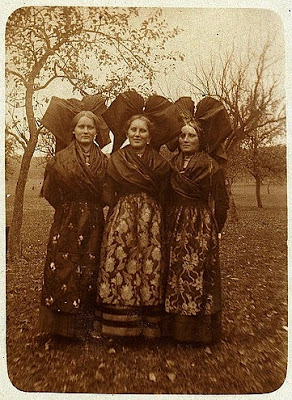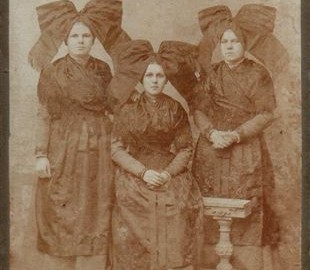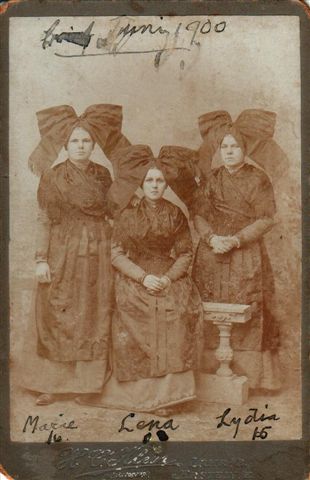My post Who’s in that photo? from September received a comment today from Jane, who had a photo she couldn’t figure out as well. She knew the names of the people in the photo (they were her great-grandfather’s sisters), but didn’t understand the significance of the massive bows on their heads. She asked if it was a fashion thing, or perhaps a religious requirement? Someone suggested to her that it might be a Jewish headdress, and thus she was asking here for advice on the photo.
Here’s the photo, one of the more interesting family photos I’ve seen:
Now first let me say, nothing about the bows looked familiar to me. I’m not an expert on Jewish headdress or historical fashion, but I was pretty sure this was not a specifically Jewish headdress.
So what is its significance? Considering all three sisters are wearing the same headdress, my initial guess was that it would not be simply a fleeting fashion choice, but had to have some cultural or religious significance. How many sisters do you know who otherwise would wear the same outfits?
I can’t say for sure that I know the origin of these bows, but I suspect from the research I did that these are in fact Alsatian headdresses called schlupfkàpp (a ‘bow cap’). In the 19th century the region of Alsace-Lorraine developed a unique form of headdress that lasted into the 1940s before mostly disappearing. Early in the 19th century the bows were relatively small, but apparently the bows grew in size until they peaked in size around the turn of the century, exactly when Jane’s photo was taken.
Here are a few examples of the style:
 |
| 1919 illustration of traditional Alsatian costumes (Wikimedia Commons) |
 |
| Husband with wife in traditional Alsatian costume, about 1875 (Christ Family) |
 |
| Three sisters in Alsatian folk dress (Flickr) |
Most sources point out that single women wore these bows in specific colors indicating their religion – Protestants wore Black bows, and Catholics wore brightly colored ones, usually Red. Apparently after marriage both Protestants and Catholics would wear black bows. One source I found mentioned that Jews wore Lavender bows, although I haven’t found any other reference for that fact.
I certainly can’t determine the color of the bows in Jane’s photograph since it’s black and white, so even though they seem black to me that might not be the case. I also can’t read the location of the studio where the photograph was taken, although it could have been taken anywhere (although if it is in Alsace-Lorraine that would certainly seem to confirm my guess).
What I would suggest for Jane is to try to contact someone who knows about traditional Alsatian costumes. One other reason to do this, especially if Jane does not know what town her family came from, would be to determine the specific type of headdress her family members were wearing. Apparently the style of the bows varied from village to village, and it might be possible for someone to figure out the region or even the specific town by seeing the style of the bow.
One place to look is the Alsace Tourism web site, which has a section on Alsatian Costume. The web site even has a map showing the origin of specific headdresses in Alsace. The site also links to two different cultural groups and the Alsatian Museum in Strasbourg, all of which might be able to help figure out the specific origin of the bows in Jane’s photo. Another option if Jane doesn’t know where her great-grandfather came from is to track down his origin and seeing if he tracks back to a town in Alsace-Lorraine. If he moved to the US, she can using the techniques I wrote up previously in my article Finding Information on US Immigrants.
Certainly, this is an interesting example of using family photographs to locate the origin of a family. Even if the photo was taken in London or Chicago, it would still point to the family coming from Alsace-Lorraine and may even (with some expert help) point to the specific region or town. Of course, I don’t have a lot of information about the family and could be totally off-base. I’m sure everyone reading this would appreciate if Jane would post in the comments if my guess is right and she confirms the origin of the headdress (and her family) as coming from Alsace-Lorraine.


Philip this information is amazing, can’t thank you enough for your assistance. One of my cousins has just informed me that our great grandfather (brother of these three women) was born in Kippenheim. She said it’s not far from the Alsace-Lorraine region. – Jane
Jane, I’m glad the post was useful. It was very interesting for me to figure it out. Where does the photo frame show that the studio was located by the way?
I still don’t know if your family was Jewish or not, but I thought I would mention that there was a Jewish community in Kippenheim, although not a large one. There’s a considerable amount of information on this page (in German):
http://www.alemannia-judaica.de/kippenheim_synagoge.htm
There’s actually a lot of names mentioned on the page, and links to many other sources.
It also quotes (in English) the text from a book (Encyclopedia of Jewish Life) I was about to quote from (slightly corrected):
Kippenheim Baden, Germany. Jews are first mentioned in 1654, abandoning the village in 1689 on the approach of the French in the Nine Years War. New families, expelled from Neighboring Ettenheim, were present in 1716. The Weil family played a leading role in the community up to the 20th cent. In the 18th century Immanuel Weil held the iron and hide monopolies for the whole principality. A modest synagogue was erected in 1793 and a Jewish elementary school was opened in the 1830s. The Jewish population reached a peak of 323 in 1871, but then commenced to drop steadily through emigration and the declining birthrate. In 1933, 144 Remained, Subjected to increasing anti-Jewish agitation. By 1938, all Jewish businesses had been liquidated and 93 Jews had emigrated (58 to U.S.). On Kristallnacht (9 to 10 November 1938), the synagogue was vandalized and Jewish men were detained in the Dachau concentration camp. On 22 Oct. 1940, 31 Jews were deported to the Gurs concentration camp; another 12 were deported from their places of refuge after leaving Kippenheim. In all, 29 Jews perished in the camps, 17 of them in Auschwitz in 1942-44.
Some digging through the above page, especially by someone who speaks German, could probably figure out a lot about the Jewish community there, and if your family was part of it.
I love this type of historical research that makes genealogy come alive. I’m very happy you’re back blogging regularly — or more regularly — again. I’ve missed your posts (but understand and appreciate that you were doing vital database work).
Thank you Edie. I love your blog too.
Hello Philip.
I am told that on the photo it shows the photographers name was H O Klein and what looks like an address –
Lahr 1/B
u Epstein 1/E
Your latest information on Kippenheims Jewish community is very interesting. One of our family members recently passed away and during some medical tests she had around this time was discovered to be suffering from Polycythemia Vera. The doctor explained that this is a condition found mainly in people of European Jewish descent.
Jane
My great-grandmother was a Lutheran living in Riedlingen, Baden, Germany, near Alsace-Lorraine. She was photographed in 1920 wearing the large black hair bow. My mother said it was called a ‘tratz’(?), an ‘Alemannisch’ traditional style.